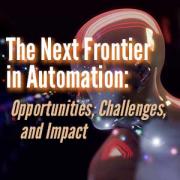CUTTER BUSINESS TECHNOLOGY JOURNAL VOL. 32, NO. 2
We’re entering a new era in automation as we begin to embrace smart automation and autonomous systems that can make and execute decisions in several areas with little human intervention. Advances in areas such as artificial intelligence (AI), machine learning (ML), robotics, drones, robo-advisors, blockchain, 3D printing, and wearables are driving automation into the next frontier. The desire by businesses and industry to better exploit the potential of these technologies for improving decision making, productivity, reliability, customer service, and user interaction, and for reducing cost and errors is another factor driving automation to newer heights. The continuing desire to deploy novel applications for competitive advantage is also propelling automation into new areas to accomplish sophisticated tasks. Automation, which traditionally has been confined to within an enterprise, is now being extended to the enterprise’s suppliers and customers and others in the supply chain, enriching integration and collaboration.
Today’s ongoing smart automation efforts are promising and are poised to drastically transform the world — both in what we do and how we do it — for good, in large part. While smart automation is a welcome trend, it also raises technical, social, and ethical issues and challenges that need to be critically examined and satisfactorily addressed. In this issue of Cutter Business Technology Journal (CBTJ), we examine the next frontiers in automation: technologies, opportunities, challenges, and design guidelines.
Automation has evolved significantly over the past 50 years. It was first achieved by mechanical, hydraulic, and pneumatic means, followed by, and in combination with, electrical and electronic devices and, more recently, by microcomputers and computers. Now, with AI, Internet of Things (IoT), and other recently emerged technologies supporting automation in new ways, smart — or intelligent — automation has emerged.
Smart automation is rapidly infiltrating all industry sectors and, through its many incarnations, will affect our lives and work in myriad ways. We are striving to exploit the opportunities that the next frontiers in automation present. To gain dominance in this emerging area, competition is heating up among technology giants as well as startups. On the one hand, ongoing developments and the resulting possibilities are impressive and likely to further profoundly transform the world, benefiting business, industry, and people in general. On the other hand, concerns as to the ethical, reliability, and safety implications and the potential harmful effects of new automation applications on jobs, the economy, and geopolitical matters are troubling.
It is our responsibility to shape the future of automation for the good of all, satisfactorily addressing its potential harmful effects and any real concerns. As businesses start to implement smart technologies to automate processes and activities, we must look at automation with a new mindset, holistically, broadening our vision. We need to move from traditional opportunistic automation of processes, which offers incremental benefits, to systematic, organization-wide automation of processes to gain dramatic benefits across an organization’s activities. However, we shouldn’t blindly pursue and embrace automation without examining the need for it, its relevance, and its consequences.
Advanced automation is a new, strategic, technological and business imperative. In the next five to seven years, it will be pervasive and become the new normal, as everything that can be automated will be automated (subject to addressing any concerns). Organizations that fail to pay attention to the next frontiers in automation are putting themselves at risk. Start preparing now for the new world of automation, using this issue of CBTJ to help you in the endeavor.
In This Issue
We feature eight articles in this issue that cover a range of topics of interest — from technologies that drive and support new frontiers in automation, such as blockchain, AI, and security, to automation strategies and design considerations.
In our first article, Thomas Costello and Phil Laplante focus on the use of blockchain technology in automation applications. Following a brief outline of the benefits of using blockchain technology, they discuss blockchain’s potential to provide transformational improvements in business process automation (BPA) in several industry sectors. They also highlight how blockchain could improve trust in, and the dependability of, BPA and examine the challenges in practical implementation of blockchain technology. Furthermore, they present a set of customizable questions to help implementers decide whether a business process is suitable for, and can benefit from, a blockchain implementation.
Next, Cutter Consortium Senior Consultant Paul Clermont discusses the adoption and impact of AI for automation. After a brief history of AI, Clermont discusses the dangers AI poses. Though technologists have perceived the dangers for some time, he notes that only now are the dangers starting to draw the attention of ordinary citizens and politicians. On a positive note, he outlines the measures that government, the tech industry, regulatory agencies, and the public are taking to address major dangers that AI and its applications present. He emphasizes government’s role in tackling the issues surrounding the use of AI and identifies a few specific areas that government should address.
The following article explores another hot topic: drones and their applications. Cutter Consortium Senior Consultant Helen Pukszta outlines several potential enterprise applications of drones in different industry sectors with illustrative real-world examples. She briefly highlights how Part 107 of Chapter 14 of the US Code of Federal Regulations redefines commercial drone use and the risks drones pose. She also discusses the challenges and limitations of today’s drones and how those concerns are being addressed. The barriers to employing drones for business are quickly melting away, and it’s time to pursue the opportunities that drones present, she advises.
While modern automation systems offer several benefits, they also increase security risks, and securing these systems is a major challenge. Traditional techniques don’t seem to be adequate to address the potential new security threats; we need a cybersecurity strategy that can counter cyberattacks effectively and efficiently. In her article, Prerna Lal discusses the use of ML techniques to address cyberthreats and explores the benefits of AI-based cybersecurity solutions.
The next four articles focus on automation design, a roadmap for robotic process automation (RPA), decision automation challenges and opportunities, and accountability of the algorithmic systems that play key roles in automation.
Aravind Ajad Yarra emphasizes that automation is most effective when humans and machines work together to deliver business outcomes and recommends that automation be designed in harmony with human experiences and business processes. He outlines three types of automation — experience automation, process automation, and platform automation — on which smart automation manifests, considers some smart automation fallacies, and examines how a design thinking approach can successfully be applied to smart automation, including a discussion of the three dimensions of design considerations for smart automation: human factors, systems and technologies, and business processes.
RPA, a technique that automates routine and repetitive human-system interactions across functional domains in several areas, is transforming the way that banks, insurers, and other firms execute basic processes. In his article, Mohan Babu K presents a roadmap for rolling out RPA and examines RPA solutions from key vendors. He then presents a snapshot of real-world stories of RPA adoption across industry domains and, based on his personal experience, recommends five key design topics to consider in rolling out scalable RPA solutions.
Decision automation is a technique that uses AI and other techniques to make routine, recurring decisions with higher decision speed, consistency, and accuracy. Daniel Power and Ciara Heavin discuss the need for — and the benefits of — automating decisions and decision processes and explore major areas of decision automation. They examine emerging, innovative sensing technologies — such as ambient intelligence and the IoT — that support decision automation and identify five major challenges and opportunities associated with deploying decision automation and sensors.
In our concluding article, Yiannis Kanellopoulos addresses a key issue that we need to satisfactorily tackle: the accountability of algorithmic systems. Automated decision making can go seriously wrong, and hence, evaluating an algorithmic system and the organization that utilizes it in terms of their accountability and transparency assumes ever greater importance. Such an evaluation, however, faces some key challenges, including the absence of a widely accepted evaluation standard and the reluctance — or refusal — of organizations to evaluate the system. His article presents a framework for assessing the transparency of an algorithmic system based on the way the system has been implemented and governed in terms of accountability. He recommends establishing and following such an evaluation process as a prerequisite for organizations to deploy an algorithmic decision-making system.
The Way Forward
We’re now at the beginning of a new automated age. Like it or not, advanced intelligent automation will affect many areas in new ways, some of which we can’t yet visualize. As smart automation, autonomous systems, and robo-advisors shape business, finance, industry, smart factories, healthcare, education, and other areas, new opportunities will arise for the IT industry and technology professionals. They should resolve to apply automation for good — for the benefit of both businesses and people — and not for any nefarious purpose.
Smart automation will be pervasive, and new, exciting, and helpful applications will emerge. Automation will also be disruptive, impacting businesses, the job landscape, and society. It will free up humans to spend more time on cognitive and high-value activities rather than on mundane and physical operations. It may also embrace both artificial and human intelligence working in harmony — man-machine collaboration — to address complex problems that neither can handle alone.
While the IT industry and business and technology professionals may be adept at designing and deploying innovative applications addressing key technology-related issues, they together also need to examine and address new issues such as:
-
How might we effectively address emerging cyberthreats that automation systems might encounter, including obscure, new, and unknown (future) threats that could be serious or even catastrophic?
-
How do we ensure that automation and algorithmic decision-making systems and humans work together collaboratively?
-
How can we test and evaluate smart automation systems and establish their trust-worthiness?
-
Are the concerns and fears around the possible threats posed by emerging, higher levels of automation with no or minimal human intervention overhyped or real, and how can we address them?
-
Should automation technologies and applications be regulated, and, if so, how and by whom?
-
What are the moral and ethical obligations and responsibilities of smart automation application developers and of those who embrace the applications?
We hope the articles in this issue present perspectives and ideas on a few key aspects of smart automation and that you find the articles interesting, insightful, and practical. We also hope they inspire you to harness the innovations pushing the next frontiers in automation.



